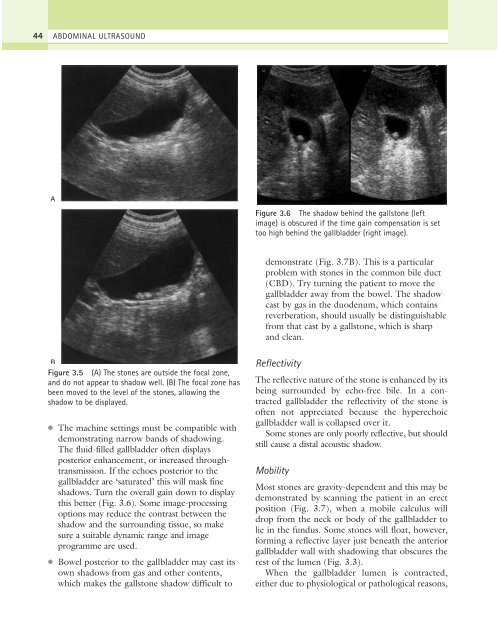9%20ECOGRAFIA%20ABDOMINAL%20COMO%20CUANDO%20DONDE
You also want an ePaper? Increase the reach of your titles
YUMPU automatically turns print PDFs into web optimized ePapers that Google loves.
44<br />
ABDOMINAL ULTRASOUND<br />
A<br />
Figure 3.6 The shadow behind the gallstone (left<br />
image) is obscured if the time gain compensation is set<br />
too high behind the gallbladder (right image).<br />
demonstrate (Fig. 3.7B). This is a particular<br />
problem with stones in the common bile duct<br />
(CBD). Try turning the patient to move the<br />
gallbladder away from the bowel. The shadow<br />
cast by gas in the duodenum, which contains<br />
reverberation, should usually be distinguishable<br />
from that cast by a gallstone, which is sharp<br />
and clean.<br />
B<br />
Figure 3.5 (A) The stones are outside the focal zone,<br />
and do not appear to shadow well. (B) The focal zone has<br />
been moved to the level of the stones, allowing the<br />
shadow to be displayed.<br />
●<br />
●<br />
The machine settings must be compatible with<br />
demonstrating narrow bands of shadowing.<br />
The fluid-filled gallbladder often displays<br />
posterior enhancement, or increased throughtransmission.<br />
If the echoes posterior to the<br />
gallbladder are ‘saturated’ this will mask fine<br />
shadows. Turn the overall gain down to display<br />
this better (Fig. 3.6). Some image-processing<br />
options may reduce the contrast between the<br />
shadow and the surrounding tissue, so make<br />
sure a suitable dynamic range and image<br />
programme are used.<br />
Bowel posterior to the gallbladder may cast its<br />
own shadows from gas and other contents,<br />
which makes the gallstone shadow difficult to<br />
Reflectivity<br />
The reflective nature of the stone is enhanced by its<br />
being surrounded by echo-free bile. In a contracted<br />
gallbladder the reflectivity of the stone is<br />
often not appreciated because the hyperechoic<br />
gallbladder wall is collapsed over it.<br />
Some stones are only poorly reflective, but should<br />
still cause a distal acoustic shadow.<br />
Mobility<br />
Most stones are gravity-dependent and this may be<br />
demonstrated by scanning the patient in an erect<br />
position (Fig. 3.7), when a mobile calculus will<br />
drop from the neck or body of the gallbladder to<br />
lie in the fundus. Some stones will float, however,<br />
forming a reflective layer just beneath the anterior<br />
gallbladder wall with shadowing that obscures the<br />
rest of the lumen (Fig. 3.3).<br />
When the gallbladder lumen is contracted,<br />
either due to physiological or pathological reasons,



